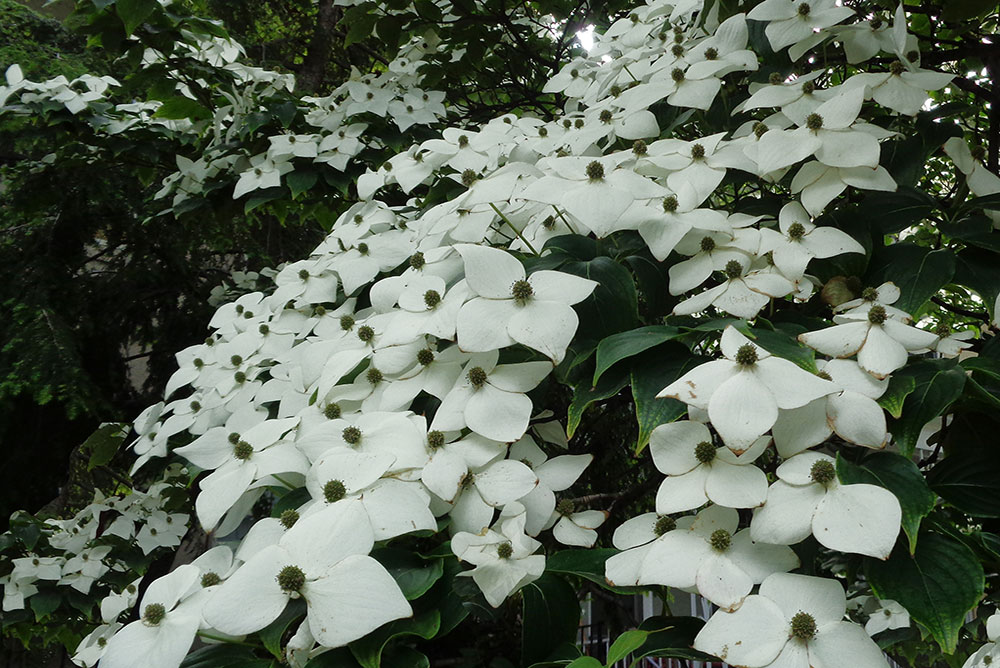
The inexplicably healthy and wonderful dogwood down the street. / Photo by Stephanie Cavanaugh.
I HAVE NO IDEA what’s growing in the front garden. It’s quite possible that my seeding technique—wait for a rainy day, tear off the top of a seed packet and scatter the seed about randomly—has worked, for a change. All sorts of unrecognizable foliage that does not look like weeds is growing thunderously, thanks to the rain, which in Washington DC this spring has been ceaseless.
My fertilizing technique closely resembles my seeding—wait for rain, throw the fertilizer around, go inside, drink more coffee, lie down on the sofa and read.
Do you know Val McDermid? She’s a sick and twisted writer, if you’re in the mood for such, which I am. Her novels are set in Scotland, where it’s wet and cold instead of wet and hot. This is refreshing. I seem to be spending a lot of mental time in Scotland lately. I don’t know about that either.
Despite various gardening thoughts that intruded throughout the winter, here it is not even Memorial Day, and I’m already lost. One would think, after 36 years in this one particular garden, some great concept would be coming to fruition. No.
Well, I do know the basic bones of the place, which I happened into for various reasons. When Baby was in the process of moving from one house to another in Raleigh, she uprooted her hydrangeas, two pinks and a green, and I stuck them in my yard. There was some vague promise of returning them when she got settled. This did not happen. She can visit them any time, however.
There is also a red-leaf maple sort of midway and off to the side, which separates our house from the neighboring property, almost giving the impression that we are completely detached. I like this notion, being somewhat antisocial. The maple replaced a floundering pink dogwood, which sent out pathetic flowers in spring and then looked diseased from late July until frost. Down the block is a white dogwood that is totally neglected and yet is the most magnificent and long-flowering specimen that I have ever seen outside the National Arboretum. I do not understand this.
The maple was, of course, a mistake. Despite being a lovely shape right now, it will grow far too big for the space in a very few years. Not so much an issue for us, but it will eventually encroach on the neighbor’s front walk. This will be a nuisance. For them.
We also have two forsythia that are planted in the way back (such as the “way back” is when the plot is only about 20 feet deep). These reliably do what forsythia do, tossing off flailing limbs of yellow flowers each spring, which either last or not depending on the heat. A couple of pinkish-red Knock Out Roses bloom endlessly in scentless boredom.
It’s the middle that is a mystery. There’s all this foliage that I don’t recall planting, an interesting mix of greens, I will say. I think I scattered zinnias and some attract-the-birds wildflower mix. How do I forget when this was just a few weeks ago?
This morning I’m thinking of adding another layer to the mystery.
Frustrated with my complete inability to grow Queen Anne’s Lace, a flower generally considered a weed, presumably because it’s as difficult to eradicate as dandelions, I bought a package of Bishop’s Lace. It is considered a tame cousin, which grows to four feet tall and has an ethereal lace cap, which is the effect I’m going for—I particularly appreciate the fireworks frill in flower arrangements.
There is, however, not a single bare patch in which to plant them, never mind scrape down an inch to cover the seeds with soil. Enter the flower bomb—seeds packed within a casing of compost and potter’s clay, dried for a few hours, then scattered about before a rain. As the casing dissolves it automatically forms the growing medium.
Except that I don’t have potter’s clay or compost, and am not about to go get some. So I shall experiment, packing seed into dampened potting soil instead. This is such an exciting thought, I can’t tell you. Maybe there’ll be flowers. Or maybe not.
If you’re the anal type, an excellent recipe for flower bombs, with all the proper directions and seed choices and so forth is at Gardenista. Go for it.
—Stephanie Cavanaugh
LittleBird “Stephanie Gardens” writes about city gardening with almost as much creativity as she exhibits in actual gardening.
MyLittleBird often includes links to products we write about. Our editorial choices are made independently; nonetheless, a purchase made through such a link can sometimes result in MyLittleBird receiving a commission on the sale, whether through a retailer, an online store or Amazon.com.

No Michelle it’s Bishop’s Lace, bought in a little packet in a garden center. HOWEVER and DESPITE your warning – I would love Bishop’s Weed. I’d be thrilled if it took over my front yard. Also the curbside garden. Off to look it up.
What?
Just read about your planting in your garden, will discuss it further when I see you next.
It’s ten minutes before noon, time for a grilled cheese sandwich….. Keep writing, maybe the rain will stop.
How you make the black-thumb gardeners among us feel sooooo good! Except, though, you do seem to get good results!
Stephanie, make sure it is not Bishop’s Weed that you are planting. The flower looks just like Queen Anne’s lace, but is invasive in the extreme, and NOTHING can kill it. A pox on you and your house, if you plant this!